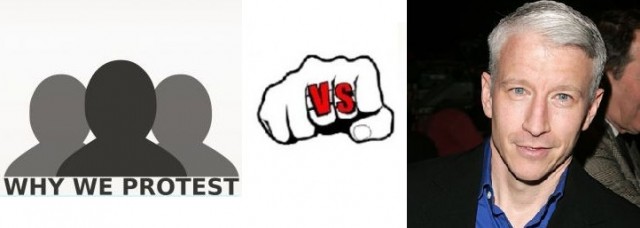 Last week, Claire Headley started us out on our journey to train as Scientologists. In 2005, Claire and her husband Marc escaped from Scientology’s International Base after many years as “Sea Org” workers. She spent years working with Scientology’s “tech,” and was trusted to oversee the auditing of Tom Cruise. This week, she helps us learn how to stare for a really long time
Last week, Claire Headley started us out on our journey to train as Scientologists. In 2005, Claire and her husband Marc escaped from Scientology’s International Base after many years as “Sea Org” workers. She spent years working with Scientology’s “tech,” and was trusted to oversee the auditing of Tom Cruise. This week, she helps us learn how to stare for a really long time
Claire, last week we took one of Scientology’s “personality tests” and found out we have all kinds of problems. So this week, we’re going to start our first course at the church. What’s it all about, and what does it cost?
CLAIRE: It’s called the “Success through Communications Course,” and it costs around $200.
It’s presented as a course that teaches the basic parts of the communication formula — the first of which is to train you just to be there comfortably.
THE BUNKER: Be there? Comfortably?
CLAIRE: It’s a baby step, and it’s called TR-0 (as in “training routine zero”). You need to sit in front of someone else with your eyes closed, and just be there.
THE BUNKER: Be there?
CLAIRE: Comfortably. Without twitching, fidgeting, or anything else.
THE BUNKER: So the first step in learning to communicate with someone is to sit still with your eyes closed and hold still. How…uncommunicative.
So at some point I guess you open your eyes and begin a staring contest with another person. I remember doing that as a kid, but it never lasted more than a couple of minutes. How long are you expected to hold a stare in the comm course?
CLAIRE: Two hours of blink-less TRs used to be a requirement, I think, in the 1970s. But that was cancelled, and minimal blinking is now acceptable for a pass.
In my years in the Sea Org, I probably did upwards of 500 hours of TR-0 eyes closed, and TR-0 eyes open.
 In 1992, when I had been at the Int Base less than a year, the area I was working in (“Qual” –- where staff training and auditing were delivered) was shut down by David Miscavige and we were required to do videotaped TRs day in and day out for 4 months until we all had passes from him. So yes, my TRs were approved by little man himself.
In 1992, when I had been at the Int Base less than a year, the area I was working in (“Qual” –- where staff training and auditing were delivered) was shut down by David Miscavige and we were required to do videotaped TRs day in and day out for 4 months until we all had passes from him. So yes, my TRs were approved by little man himself.
THE BUNKER: He is not a tall man. Claire, I’ve talked to some people who say that after they stare at someone that long, the other person’s face can begin to do funny things. What they’re describing is hallucinations.
CLAIRE: Yes, your eyes can go fuzzy and your mind might wander, but as with anything, if you practice you will get the hang of it. It’s not for nothing that Scientologists are recognizable for the glassy stare.
THE BUNKER: So after you’ve mastered communicating by not communicating, what comes next?
CLAIRE: TR-0 Bullbait.
THE BUNKER: Oh, this is when you have to keep staring straight ahead, but the other person shouts at you or acts up in order to make you flinch.
CLAIRE: Yes. When I first did Bullbait, I was horrified and scared. Honestly. Even TR-0 (staring) I thought was a complete joke. Raised in England, I was of the view it’s rude to stare at someone, and I would most often find some notable feature of the person’s face to focus on. Just honestly.
In Bullbait, the best idea I could come up with at age 10 was to imagine myself in a bubble, impervious to what was being said or done, so I wouldn’t find it funny and wouldn’t react.
The worst was to have a 40- to 50-year-old man start to unbutton my shirt. That was pretty horrifying (and pretty common, mind you). I had a tendency to blush purple back then, and so I had a real rough go of it.
THE BUNKER: I’m sorry, that sounds sort of revolting.
CLAIRE: Several times I just outright broke down in tears, and then did a real good job of hiding my tears from my supervisors.
But yes, Bullbait got pretty gruesome, with yelling and screaming and some touching. The materials state to find the person’s “buttons” — what they will react to -– and then “stomp on them hard” or words to that effect. No mercy.
THE BUNKER: We’ve heard testimonials from people who say the experience did subsequently make them stronger participants in conversation. But it sure also seems like an exercise in control, especially if it’s repeated so often, as you point out. So there are additional training routines. What’s next?
CLAIRE: In TR-1, the coach gives a flunk for anything not delivered naturally, as your own and in its own unit of time. For example:
Me: (holding a copy of Alice in Wonderland) “Curious and curiouser.”
Coach: Flunk. That was not natural.
Me: “Curious and curiouser”
Coach: Good.
Me: “Why is a raven like a writing desk?”
Coach: Good.
And so on. For TR-2, the coach reads from Alice in Wonderland and I have to acknowledge each line he or she delivers:
Coach: “Take care of the sense, and the sounds will take care of themselves.”
Me: OK.
The coach will also flunk if any of the acknowledgements were evaluative or do anything other than simply and only acknowledge the communication as heard and received.
For example, if I had said “I’m not sure what you mean by that.” I’d be flunked.
Any facial expression or reaction, during any of the TRs would also be flunked.
THE BUNKER: And in TR-3?
CLAIRE: TR-3 goes like this…
Me: Do birds fly?
Coach: Yes
Me: Thank you. Do birds fly?
Coach: What time is it?
Me: I’ll repeat the auditing question, do birds fly?
And TR-4 is very similar…
Me: Do birds fly?
Coach: Yes
Me: Thank you. Do birds fly?
Coach: I have a headache.
Me: I understand. I’ll repeat the auditing question, do birds fly?
THE BUNKER: How…repetitive. And the point?
CLAIRE: The premise of these last two is that you are training to become an auditor. Some of the key principles in auditing are “the way out is the way through” and “what turns it on will turn it off.” In other words, the key to any auditing process is to continue with the command or process no matter what happens and no matter what reactions or response you get, so you need to be trained to persist with it despite whatever may happen and for as long as necessary until you get the desired result.
THE BUNKER: We can see how that might make sense if auditing were extremely repetitive and time-consuming, and the point is making a person loopy. Which we’ve heard is the case. Well, that’s an interesting start to things. If, that is, we were training to question a parrot. But the first step on a journey to crack open the cosmos? Well, we’ll see.
COST THIS WEEK: $200
COST SO FAR: $200
—————-
SMERSH Madness: Sowing the Seeds of World Domination!
As we announced on March 1, we’re joining bracket fever with a tournament like no other. It’s up to you to decide who should be named the new SMERSH, the traditional nemesis of Scientology. Cast your vote for who’s doing more to propel the church down its long slide into oblivion!
Continuing in the first round, we have an interesting matchup this morning.
WhyWeProtest.net is an online forum for the Anonymous anti-Scientology program, Project Chanology. Wild and woolly, the site became less about the worldwide protests that started in 2008 and more about the research being done by scores of vigilant Internet sleuths. Like any forum, its cast of characters is always changing, but document releases seem to have been particularly good in recent months.
Anderson Cooper followed up the 2009 St. Petersburg Times blockbuster series “The Truth Rundown” with his own special about violence in Scientology’s top ranks in 2010. Since then, he’s been the go-to American television figure for Scientology news, as he proved recently with excellent programs on Lawrence Wright and Jenna Miscavige Hill. Cooper knows his stuff.
See our March 1 post for the latest standings in the tournament.
—————-
Posted by Tony Ortega on March 12, 2013 at 07:00







